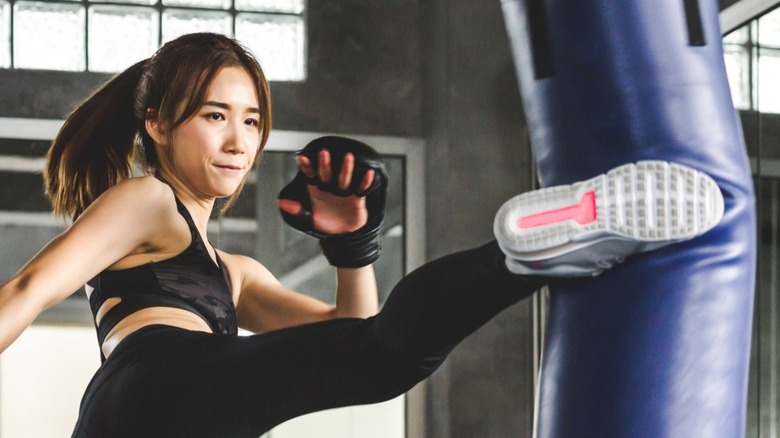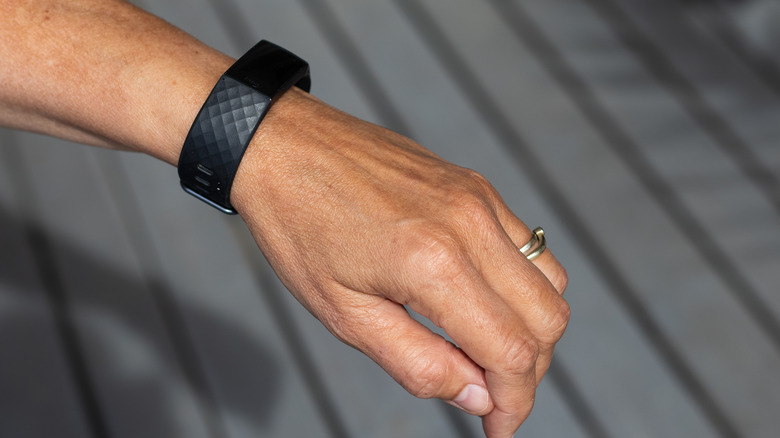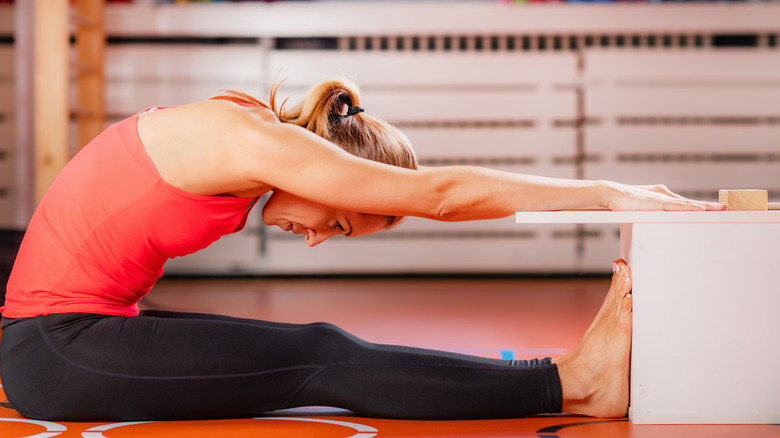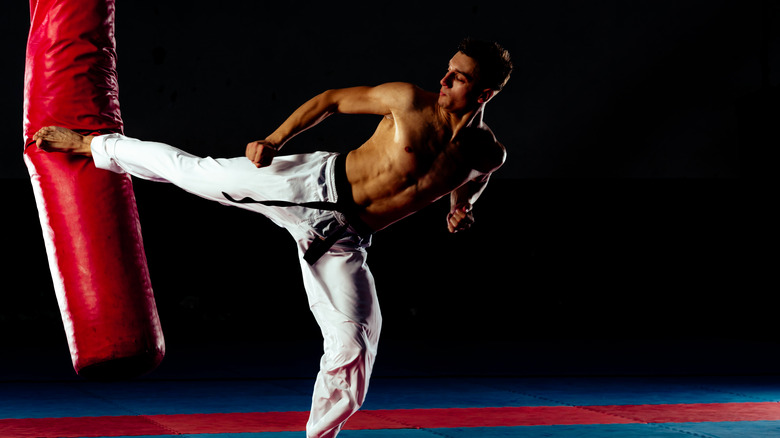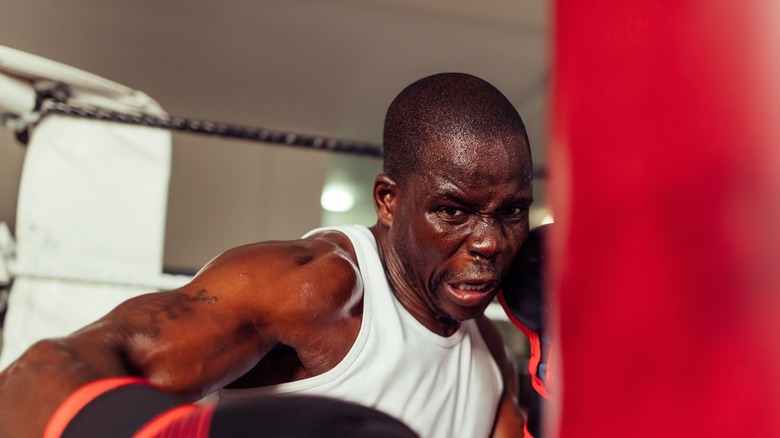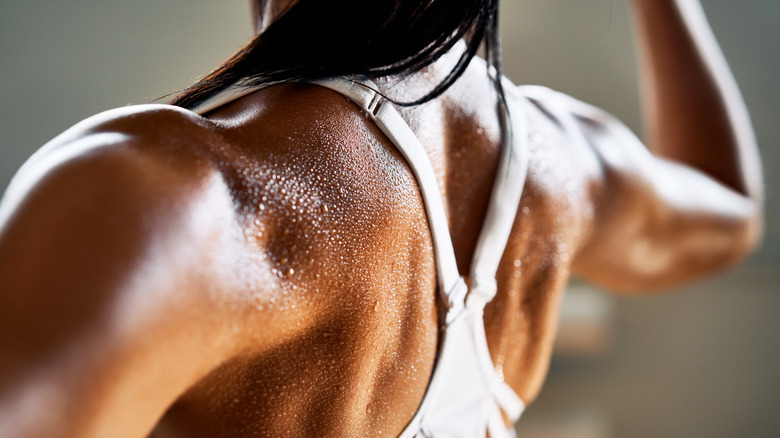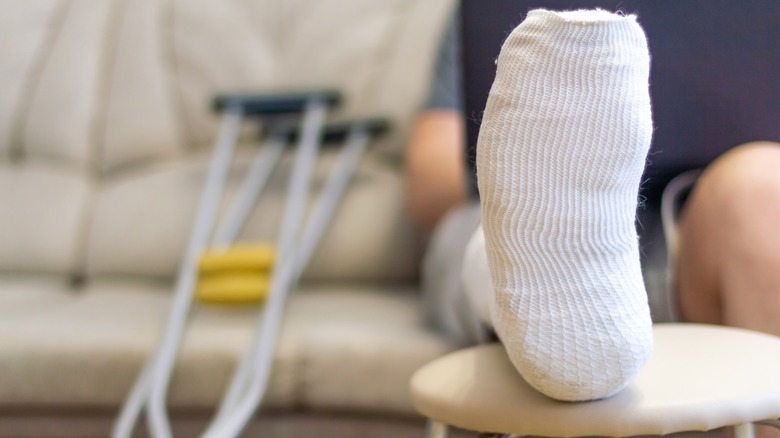What Kickboxing Really Does To Your Body
If you have to climb the stairs, wouldn't it be nice to do it without running out of breath? Or would you like to learn some self-defense moves so that you can feel more prepared and confident? Well, with kickboxing you can! According to the Columbia University Kickboxing Club, kickboxing originated in Far East Asia about 2,000 years ago. It was used as a form of self-defense training. Over time it developed as a sport and began to grow in the U.S. in the 1970s.
Boxing involves punching with your arms and using your legs and feet to move (via U.S. News & World Report). But — you guessed it — kickboxing consists of kicking with your legs as well as punching with your arms. Therefore, kickboxing exercises more of your lower body. So if you are considering kickboxing, it is a great exercise that also helps you learn to defend yourself. It also does a number of other things to your body to enhance your physical health.
You'll burn lots of calories while kickboxing
Depending on your weight, you can burn from 350 to 450 calories by doing one hour of kickboxing, according to Johns Hopkins Medicine. For someone who weighs 150 pounds, this would be similar to shoveling snow by hand for an hour (per University of Rochester Medical Center's calorie burn rate calculator). But with kickboxing, you'll probably have more fun and feel like a badass.
Calories are a form of energy that you burn when you exercise. With kickboxing, you move many parts of your body (via WebMD). And the more you move, the more calories you burn. The number of muscles you use during kickboxing might surprise you. Besides your arms, kickboxing also uses your core muscles, hamstrings, quads, glutes, and even your back. What's more, it is a high-intensity workout. In other words, kickboxing really revs up your body's engine and keeps it working hard. So put on your Fitbit, kickbox, and watch the number of calories burned climb!
Your heart might get stronger with kickboxing
Kickboxing is also a great cardio workout (via WebMD). A cardio, or aerobic, workout exercises your heart and lungs, in turn making them more fit (per the American Heart Association). This is because while you are exercising, your lungs work harder to take in oxygen. Then, your heart has to work harder to pump blood. This increases blood flow in your body so that the red blood cells can transport oxygen more quickly to all the body parts you move while you kickbox.
According to an article in Frontiers in Cardiovascular Medicine, regular exercise helps your heart in a number of ways. It lowers your resting heart rate and reduces the risk for arrhythmia, or abnormal beating. Regular exercise also lowers abnormal or excessive growth of the heart muscle. Moreover, as one study published in New Approaches in Exercise Physiology suggests, cardio kickboxing in particular could boost your heart's stamina. Exercising your heart keeps it from working harder than it needs to (via Cleveland Clinic). This is what leads to a lower heart rate when your body is at rest and what makes climbing stairs easier.
And as you may know, the Centers for Disease Control and Prevention (CDC) recommend regular physical activity to lower your risk for heart disease and heart attack. So, like eating your Cheerios, kickboxing workouts are also very heart-healthy!
Kickboxing can help you become more flexible
You probably knew that yoga can help with flexibility (via Journal of Bodywork and Movement Therapies), but did you know kickboxing can too? In fact, this is what a 2019 study in the Journal of Science and Medicine in Sport found. The study included 234 individuals, half of whom participated in 16 weeks of kickboxing training. The researchers used a "sit-and-reach” method to measure flexibility. This is where you sit on the floor with your legs straight in front of you, then without bending your knees, you reach straight forward with your palms face down and arms extended and parallel to the floor. This measures flexibility in your lower back and your hamstrings (according to an article in the British Journal of Sports Medicine).
At the end of the study, the researchers found that those who did kickboxing were able to extend their arms about four inches further than those in the control group. What's more, the sit-and-reach flexibility of those who did kickboxing improved by about five inches from the beginning of the 16-week program to the end. Researchers conclude that the dynamic movement in kickboxing loosens muscles and joints. This could in turn increase flexibility.
You can develop more muscle power through kickboxing
What does muscle power mean and how is it different from muscle strength? Well, Human Kinetics explains: Muscle strength refers to your ability to accomplish a goal in one moment, or with one single muscle contraction. For example, your muscle strength could be indicated by the heaviest box you can lift or the heaviest dumbbell you can chest press.
Muscle power, on the other hand, is the force you can exert over a short period of time. An example would be how far you can move a heavy bag by punching. Another example of muscle power is the ability to go from sitting cross-legged on the floor to standing by just using your legs and nothing else to help yourself up. Basically, muscle power makes you more agile. And in good news for regular kickboxers, research published in the Muscle, Ligaments and Tendons Journal suggests that kickboxing might improve upper-body muscle power compared to a general exercise program.
Kickboxing could help increase your aerobic power
Aerobic power is a fancy way of saying how much your cardiorespiratory system — the heart and lungs — can handle during exercise (per an article in the American College of Sports Medicine Health and Fitness Journal). It is the rate at which you use oxygen over a period of exercise. The higher your aerobic power, the greater the amount of oxygen your muscles can use within a given time frame, and the greater the intensity with which you can exercise. This means you can also burn a larger number of calories.
One research study that compared kickboxing with a general exercise program suggests that kickboxing might improve aerobic power compared to general exercise (via Muscle, Tendons and Ligaments Journal). The researchers speculate that an improvement in aerobic power is linked to the intensity and frequency with which you do kickboxing. In their study, the intensities of the sessions were in a range that helps improve or maintain cardiovascular fitness, and training sessions occurred three times per week. Given these results, it seems that doing intense kickboxing on a regular and frequent basis could increase your physical stamina.
Kickboxing may help you sleep better
If you struggle with getting enough sleep like many Americans (via the CDC), kickboxing might help with that too. Research published in the academic journal Physiology & Behavior suggests that those who do vigorous exercise may sleep longer and more deeply compared to those who do moderate exercise. And per Time, kickboxing qualifies as a high-intensity workout. Indeed, another study published in New Approaches in Exercise Physiology suggests that those who do kickboxing might sleep better than those who do not. Intuitively this makes sense: The more tired you are at the end of the day, the easier it might be to sleep.
However, scientists do not yet know the exact mechanism that can explain the link between exercise and sleep (via Johns Hopkins Medicine). There are a couple of explanations proposed by scientists (via the Journal of Physiotherapy) — for instance, that exercise changes body temperature such that it is helpful for sleep, and exercise releases endorphins, the hormones that help you feel good. And when you feel good overall, it might be easier to relax and sleep.
Kickboxing can strengthen your upper body
Kickboxing can make your shoulders, arms, and core muscles stronger (via Harvard Health Publishing). And this is very helpful when you have to lug heavy bags through the airport or open a stubborn jar of pickles. One way in which your skeletal muscles – those attached to your bones — get stronger could be due to muscle growth (via European Journal of Translational Myology). When muscles are active in intense exercise like kickboxing, they sustain injury (via University of New Mexico). Then, your body's process of repairing the muscle damage is what leads to an increase in muscle size. Cells that exist immediately outside of your muscle fibers gather at the site of injury. These cells then fuse themselves together as well as fuse with your muscle's fibers. This can generate new muscle fiber strands or repair the damaged ones. As a result, your muscle gets bigger. Factors that can influence how much your muscles can grow include sex, age, and genetics.
So if you have sore muscles between 24 and 48 hours after kickboxing, that is normal, says WebMD. It just means that you have put more stress on those muscles than they are used to. It is a mild injury that causes damage to your muscle fibers, which will in turn grow the muscles. Some ways to deal with and minimize sore muscles include stretching before and after your workout and getting a massage.
Kickboxing could enhance your immune system
Researchers have debated whether exercise, especially vigorous exercise like kickboxing, can strengthen your immune system. However, a review in Frontiers in Immunology provides support that it can. For instance, intense exercise can improve your immune system's response to vaccination. Vaccination injects killed or weakened forms of germs (like COVID-19) into your body to train your immune system to fight them (via the World Health Organization). That way, if you get infected, your immune system can handle it more effectively. In addition to enhanced vaccine response, the normal age-related decline of your immune system may be suppressed with regular exercise (via Frontiers in Immunology).
Researchers do not know exactly what exercise does to enhance your immune system, but there are some theories (via MedlinePlus). One is related to your body temperature rising both during and immediately after exercise. This increased body temperature might keep bacteria from growing. It could also help you fight infection better, as when your immune system provokes a fever in an attempt to kill harmful pathogens. Another theory is that exercise helps your white blood cells to circulate faster. These are cells of your immune system that fight disease. The speculation is that by traveling more rapidly, white blood cells can detect illness earlier. Or, some experts posit that physical movement could help flush out bacteria from the lungs and airways. This might reduce your chances of getting sick.
You might feel less anxious by kickboxing
About 31% of Americans struggle with anxiety at some point in their lives (per the National Institute of Mental Health). While anxiety and worry are normal parts of life, those with anxiety disorders have frequent and extensive anxiety that does not go away. Moreover, the anxiety can worsen over time. There are various types of anxiety disorders. Generalized anxiety disorder is one that involves at least six months of uncontrollable worry related to a few different parts of life, such as work, school, and family (via Johns Hopkins Medicine). Panic disorder involves unexpected and recurring panic attacks (via National Institute of Mental Health). Panic attacks are intense bouts of fear with physical symptoms such as chest pain or shortness of breath.
There are a few ways in which kickboxing could help to reduce anxiety (via Harvard Health Publishing). For one thing, physical activity lowers muscle tension. This can lower your body's contribution to feelings of anxiety. Another is that increasing your heart rate increases natural chemicals in your brain that play a role in anxiety. One such chemical is serotonin, which is involved in functions such as mood and sleep (per the Cleveland Clinic). In order to reduce anxiety as much as possible, it is important to choose an exercise you enjoy (so that you will do it regularly), increase your heart rate, and perhaps work out with a friend or group (per Harvard Health Publishing). And kickboxing, especially if you take a class, can provide all three of these elements.
Kickboxing could help lower depression
Like anxiety, depression is also something many Americans struggle with — more than 8% of U.S. adults, or 21 million people, have had a major depressive episode (via National Institute of Mental Health). This is defined by at least two weeks of symptoms such as persistent low mood, decreased interest in activities you used to enjoy, poor concentration, lack of energy, withdrawing from others, or thoughts of suicide.
One study in the Journal of Affective Disorders suggests that high-intensity exercise can lower depression more than very low-intensity exercise. Another study in the Journal of Science and Medicine in Sport found that moderately intense cardio exercise done three times per week lowered symptoms of depression if done for at least four weeks.
One way in which high-intensity exercise such as kickboxing helps depression is by releasing endorphins (per Harvard Health Publishing). These are hormones that make you feel good, and as a result can help you fight against depression. Another way in which activities like kickboxing can help reduce depression is by diverting your attention from depressing thoughts to focusing on the activity (via the Mayo Clinic). Additionally, if you set a goal or challenge for exercise (for instance going from a short kickboxing class to a long one), you can become more confident, have more self-esteem, and cope with stressors in healthier ways.
If you or anyone you know is having suicidal thoughts, please call the National Suicide Prevention Lifeline by dialing 988 or by calling 1-800-273-TALK (8255).
You might sustain injuries by kickboxing
Like any type of physical activity, kickboxing comes with cons as well as pros. One downside is that you are more likely to sustain physical injuries doing high-intensity workouts like kickboxing compared to safer and lower-intensity exercises such as walking or yoga (via WebMD). Johns Hopkins Medicine shares that there is good and bad pain when it comes to exercise. Good pain would be a mild burn in your muscles during the activity, or mild soreness or fatigue after your workout. Bad pain, on the other hand, may happen if you have not exercised in a long time and then take a 60-minute kickboxing class. You likely will experience muscle soreness so bad that it hurts to move, is sensitive to touch, or may even swell. In severe cases, this could mean permanent damage to muscles. You could also experience joint pain.
Kickboxing can also lead to lower body injuries such as twisted knees or broken toes, or upper body injuries like a damaged rotator cuff (via IDEA Health & Fitness). The key to minimizing injury is to do the kicks and punches properly. For this reason, rather than starting kickboxing on your own, it may be best to first join a class where you can learn proper techniques.
Kickboxing can cause long-term strain on your body
Intense exercise like kickboxing comes with the possibility of increased inflammation (via European Journal of Applied Physiology). Inflammation is caused by your immune system responding to an invader, increasing blood flow to an injured area to fight infection and repair damage. But not all inflammation is good. Sometimes the immune system attacks the body's own cells, such as in rheumatoid arthritis where joints are constantly inflamed (per National Institutes of Health). Moreover, increased inflammation could be linked to lower levels of iron (per the European Journal of Applied Physiology). Iron is a nutrient your body needs to carry oxygen throughout (via National Institutes of Health). Without enough iron, you can experience issues such as less energy and memory problems. So with kickboxing, as with most things, moderation is key.
In addition to being an intense workout on its own, kickboxing is also sometimes incorporated into high-intensity interval training (HIIT) programs (via HIIT Kickboxing). And HIIT workouts can also cause health problems (via Scientific American). HIIT is a workout where you alternate between brief bouts of high-intensity exercise with shorter periods of rest or low-intensity exercise. According to the U.S. News & World Report, one benefit of HIIT is that you can burn more calories in less time. However, doing HIIT too often can cause your metabolism to begin working less effectively (via Insider). Therefore, you want to do HIIT kickboxing no more than twice per week in order to get the benefits while minimizing the risks (per Scientific American).

